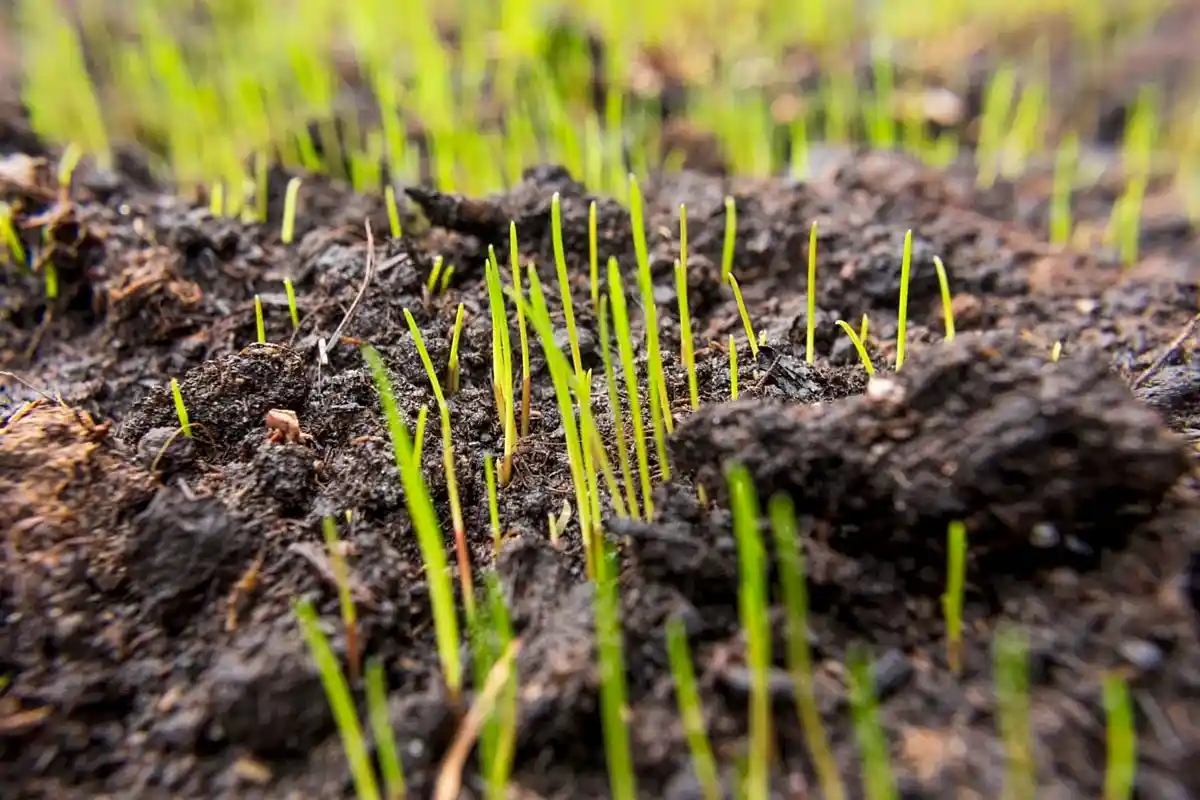Learn how long it takes to grow grass and tips to speed up the process.

From Seed to Lawn, How Long Does It Take for Grass Seed to Grow?

Growing new grass from seed requires patience. To be successful, you’ll need to prepare carefully, then water often and wait. With time, your efforts should result in a healthy, thriving lawn. So, how long does it take for grass seed to grow? It depends on a host of factors, from location and grass type to sunlight and soil quality.
Ahead, we’ll explore how long it takes for grass to grow, troubleshooting tips and ways to potentially speed up the process. To help guide you, we’ve enlisted lawn care experts Joe Churchill from Reinders and Ryan Mange from CMS Landscaping.
On This Page
How Long Does It Take Grass Seed To Grow?
It takes between seven and 30 days for grass seed to germinate and grow, depending on the type of grass. For example, fescue grass germinates in seven to 14 days, while Kentucky bluegrass takes 14 to 30 days. Other factors like temperature, sunlight and soil quality impact the length of time grass takes to grow.
Why Is My Grass Seed Taking So Long To Grow?
You may have planted a slow-to-germinate grass type like Kentucky Bluegrass, or perhaps you chose to plant in the spring. “Expect sluggish results during spring seeding,” Churchill says. Temperature fluctuations, rainy spells and weaker sunshine can make it a slow process. If your grass is taking an unusually long time to grow, here are some other reasons why:
Incorrect watering
Not watering new grass seed enough will kill it, but overwatering can delay germination or cause rot. In dry conditions, aim for a daily watering of 10 to 15 minutes.
Cool weather
Grass grows slowly in air and ground temperatures that are too cold. “Soil temperatures need to be at least 55 degrees for most species,” Churchill says. Wait for seven to 10 days of 60-degree air temperatures for soil temperatures to reach 55 degrees. Warm-weather grass will need ground temperatures of 65 degrees.
Lack of sunshine
Grass seeds need the sun’s rays to germinate. Seedlings rely on it for photosynthesis and will grow slower under persistent cloud cover.
Sub-par seed quality
Inexpensive grass seed often has lower germination rates or is mixed with weed seeds for a lower-quality lawn. Opt for a well-established, name-brand grass seed that is suited for your local climate.
Grass species
As mentioned, some species germinate slower than others. “Most cool-season grasses ideal for lawn areas typically take from seven to 21 days to germinate, depending on the species of grass,” Mange says. Warm-weather grasses can take up to 30 days.
Poor soil quality
Newly sprouted grass seed draws nutrients it needs to grow from the soil. Poor-quality soil without organic matter and low nutrient content can cause slow-growing grass. “It is important to have good soil that the seeds are sown into,” Mange says.
Ways To Speed Up Grass Seed Growth
Provide grass with optimal soil, water and temperatures for the fastest germination rate. But don’t try to force it. “This can lead to stressed conditions in the lawn,” Mange says. However, there’s nothing wrong with encouraging grass to grow as fast as it naturally can. Here’s how:
Choose the right seed
Choose a grass type suited to your local temperatures and climate. Cool-weather grasses, like fescues and ryegrass, grow best in temperatures of 55 to 75 degrees. Warmer-weather grasses, like Bermuda grass, will perform best between 75 and 95 degrees.
Prepare the soil
Test your soil, then amend it with any missing elements. “Good soil has a neutral to slightly acidic PH level, has the right mix of sand, clay and silt particles and incorporates organic matter,” Mange says.
Seed at the right time
Time your seeding to the season that provides the best temperature and weather conditions for your grass types. “The best advice for a homeowner would be to time their seeding projects when soil temps are optimum,” Churchill says. Plant cool-weather grass in early fall and warm-weather grass in late spring or early summer.
Use a starter fertilizer
Some grass seed comes packaged with starter fertilizers labeled as “feed and seed” products. For seed that doesn’t come with fertilizer, add a low-nitrogen, high-phosphorous starter fertilizer after putting down seed.
About the Experts
- Ryan Mange is a Lawn/Plant Health Manager at CMS Landscaping, a full-service lawn care and irrigation company in Holyoke, Massachusetts. He is also an International Society of Arboriculture (ISA) Certified Arborist.
- Joe Churchill is a Senior Turf Specialist for Reinders, a major distributor of lawn care products throughout the Midwest. Churchill is certified in Turf Management and has over 25 years of experience in the turfgrass industry.




















